Demand Forecasting Overview:
Demand forecasting is the act of anticipating the quantity of customers who may require certain products or services in the future, especially through analysis of previous records as well as observations made on the market. Demand forecasting is a crucial component of inventory management, supply chain management, cost control, and, customer satisfaction. This helps organizations to plan for their resources well in advance to enhance the competitiveness and profitability of their business.

Why is Demand Forecasting Required?
Planning of demand is important for several reasons. This is also effective for businesses since it makes it possible for them to forecast the needs of the customers in order to prevent overstocking or running out of stock of certain products. This results in higher levels of customer satisfaction and, consequently, customer loyalty. Forecasting leads to effective planning and budgeting, avoiding wastage through the accumulation of unsold stocks or having to procure goods under pressure.
Types of Demand Forecasting:
Depending on the criteria used, demand forecasting can be categorized into different types in terms of time horizon, data source, and methods used in it. These are passive forecast and active forecast, short-range forecast and long-range forecast, internal forecast, and external forecast. Each type is applied for different business needs and offers a different vision of demand forecasting and planning.
Passive Demand Forecasting:
Passive demand forecasting mainly focuses only on past trends and sales to anticipate future demand. CMA assumes that the factors that determined the level of activity in the past will remain the same, which makes the method ideal for companies with low sales volatility. This method is easy to use and does not require cumbersome calculations, but it does not take into consideration external factors that may affect future demand such as market trends, and seasonality, among others. Consequently, it tends to be less suitable for conditions characterized by high levels of change, such as a dynamic market.
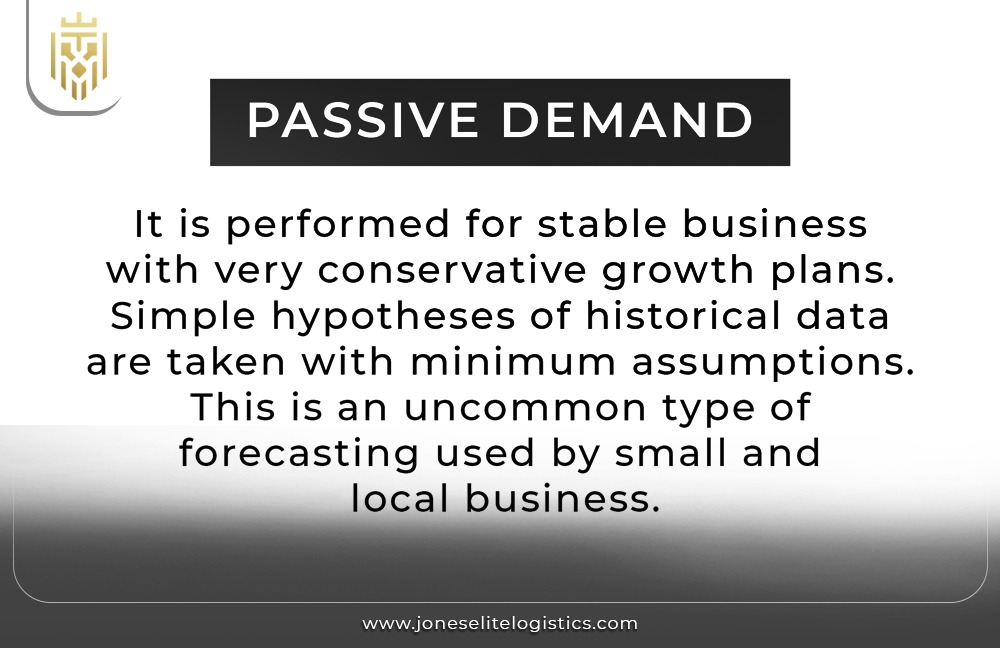 Active Demand Forecasting:
Active Demand Forecasting:
The active demand forecasting model incorporates other variables like market ambiance, economic forces, and competitor maneuverings. As compared to the traditional process, this method has a statistical orientation and the quality and flexibility of the prediction is superior because it tends to reflect actual real-time data and market intelligence. It is especially useful for organizations located in unpredictable territories or for those that plan to launch new products to the market as it provides opportunities to respond to the changes promptly.
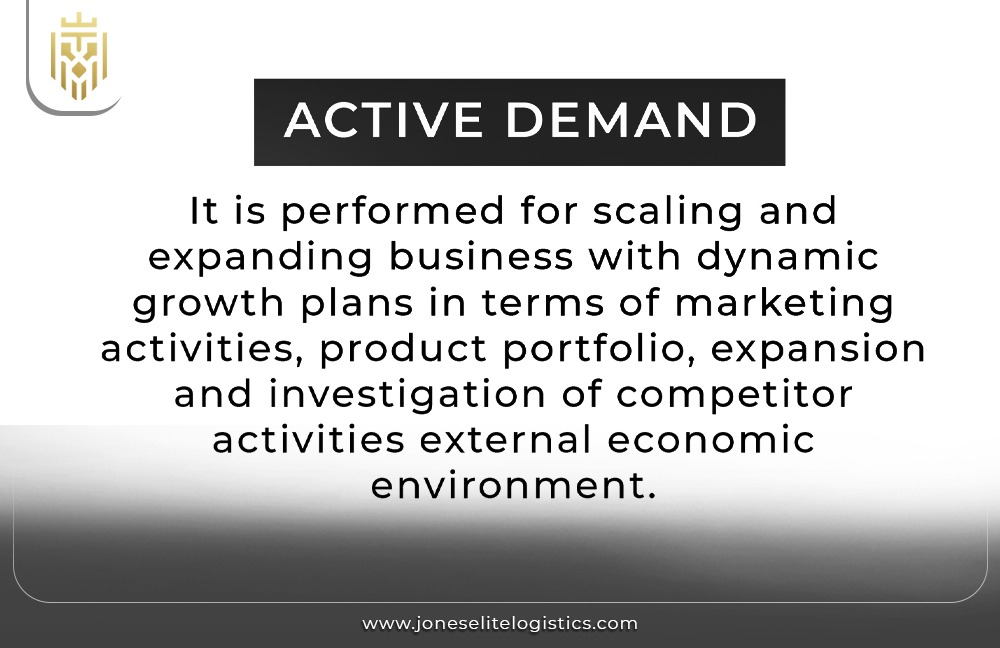
Short Term Projections:
For the shorter-term, which may range from a few days to a few months, durations, the amount, and type of demand are predicted through short-term projections. These forecasts are helpful when it comes to establishing operating schedules like those of supplies, products, or even employees. They are more important when it comes to the organizational operational level and where the physical supply has to match the current consumer orders.

Long Term Projections:
Long-term forecasts are made with an effort to forecast usage in the future, usually a few years ahead. They are useful in developing operative plans, increasing capacity, and making capital-intensive decisions in the long run. They help in the development of strategic forecasts and optimations for future growth, focus, and positioning, which guarantees continued competitive advantage and profit.

Artificial Intelligence Forecasting:
AI forecasting involves the use of Artificial Neural Networks and other related techniques, to predict the magnitude of demand. AI operates on voluminous data, deciphers highly complicated relationships, and makes precise predictions with the least required human intervention. It sharpens accuracy and flexibility and is particularly relevant when operating in volatile environments that frequently change.

Internal Demand Forecasting:
Internal demand forecasting entails the use of data collected within the organization including sales records, production data, or other analytical data that is collected by the organization. This approach assists the organization in synchronizing internal resources and processes with expectations for demand to enhance organizational effectiveness and coordinate across functional units. From internal sources, it is possible to track key variables, monitor performance, and allocate resources for inventory, manufacturing, and personnel effectively.
External Demand Forecasting:
External demand forecasting also takes into account the factors outside the business environment such as market analysis, economic factors, and competitors. This helps in getting a wider picture of the market and enables businesses to forecast the external factors that may affect demand including changes in the economy and other factors such as changes in the law and other business responses. Hence, the integration of external data helps companies improve their strategic operations, greater responsiveness to market conditions, and make rational judgments concerning product development, promotion, and particular entry to certain markets.
Demand Forecasting Techniques:
We will briefly review the various demand forecasting methods: simple historical values, and more complex methods that incorporate multiple factors. Some of the conventional methods include the moving average method, weighted moving average method, exponential smoothing, and regression. Other advanced approaches comprise that of artificial intelligence and machine learning algorithms.
Traditional Demand Forecasting:
The conventional approach to demand forecasting uses documented records and statistical techniques to estimate future demand. These methods are less complex and are usually easier to understand and adopt while trying to predict market demands using past data as a guide.
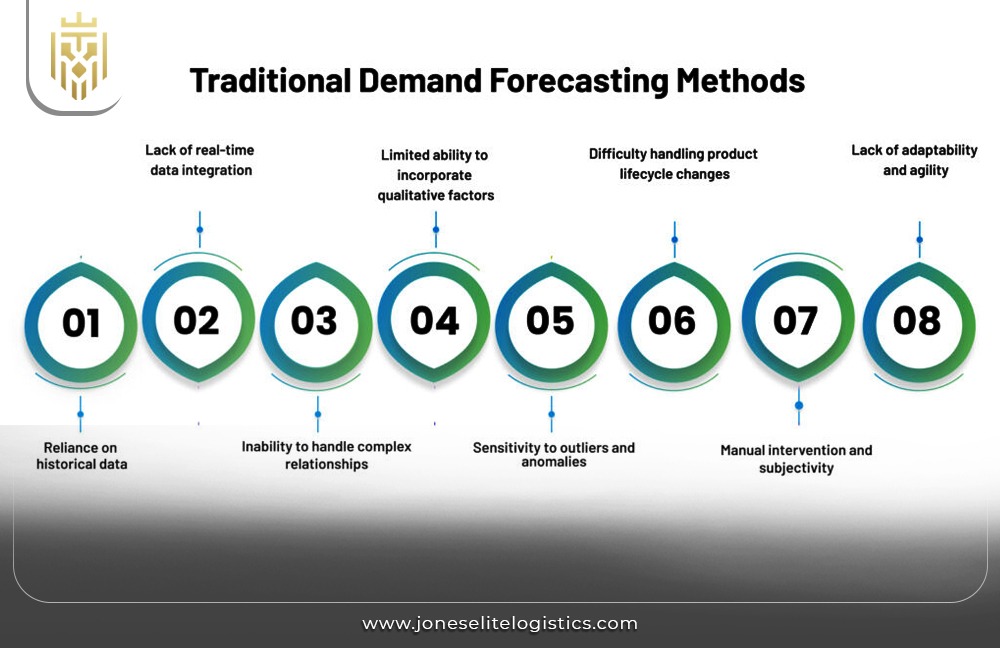
Moving Averages:
Temperature averages remove finer details and stress long-term trends in data. It entails taking the mean of the sales records with a given time period and reclining it on other data as it comes in. This strategy is useful for pattern identification and can be quickly applied, however, it is less sensitive to real-time demand changes and may take more time to adapt.
Weighted Moving Averages:
Weighted moving averages involve giving different weights to the data as opposed to simple moving averages where equal weights are given to the observations with the recent ones being weighted more. This method also increases the sensitivity of the forecast to recent demands because the recent values are given more weight. The weights are liftable in order to enhance the forecasts, which gives a precise current visualization and makes predictions more accurate.

Exponential Smoothing:
The principle of exponential smoothing is used to predict the future demand and it involves using variance weights that decrease as the time period increases. This involves the process of making small forecasts and updating them frequently, thus making them suitable for the short-run forecast only. It also has a weighting constant which controls how quickly the weights drop, to cater to flexibility in responsiveness.
Regression Analysis:
Using regression models the ability to identify and quantify the level of dependency that exists between different variables is forecasted for future use. It constructs a statistical relationship for the dependent variable –demand and independent variables – the factors that influence the demand. Incorporation of more factors can be done in this method and the effects of these factors on the demand can also be analyzed in the process- this makes this method appropriate to be used in complex situations in the process of forecasting.

Bottom-Up Forecasting:
Bottom-up forecasting involves compiling individual forecasts of various departments or product lines within the organization to obtain overall demand forecasts. This method relies on small amounts of data and information, as well as insights from the various business segments. It makes certain that forecasts are linked to certain realistic operational situations and is most effective for organizations with broad varieties of products or that sell in numerous segments.
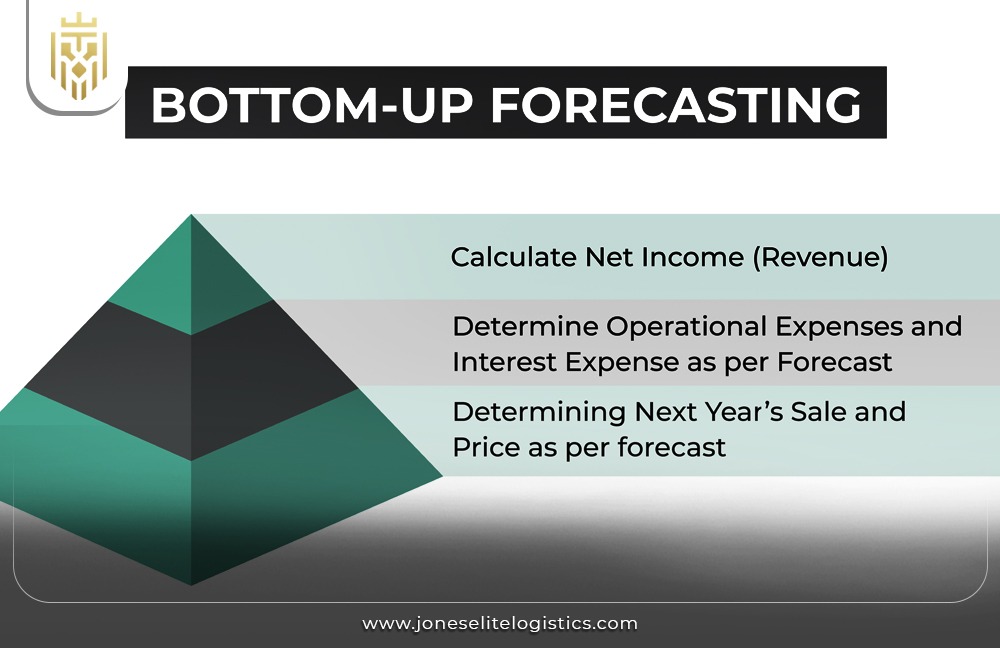
Top-Down Forecasting:
The top-down approach is a reverse of the bottom-up method which encompasses the general market estimation as a whole and then deploys it to certain segments, regions, or products. Often it is founded on such forecasts as macroeconomic variables, tendencies of definite industries, and findings of market research. It offers a greater scope in demand view and is more relevant in strategic planning in comparison with market plans, but it lacks several operational details.
Demand Forecasting Latest Techniques:
Modern methods of demand forecasting also involve the use of sophisticated technologies such as machine learning, artificial intelligence, and big data analysis. These methods increase the reliability and flexibility of the business environment by processing large amounts of data in real-time mode, recognizing intricate patterns, and making accurate forecasts. Intelligent strategies like neuro computing, machine learning, and analytics help to understand the consumer demand pattern in a better way, adapt to the dynamic business environment, and respond to it effectively, resulting in outcompeting.
Methods of Demand Forecasting:
There are two types of demand forecasting techniques, which include the qualitative method and the quantitative method. Key methods include barometric techniques, judgmental techniques, market research, the Delphi technique, macro-environmental forecast, and sales forecast trend analysis. These differ in terms of complexity of analysis and usage ranging from reliance on the opinion of experts or survey of the market to statistical and econometric models.
Barometric Methods:
Barometric methods involve the use of indicators in an attempt to forecast future demand. Such measures like GDP, unemployment rates, and consumer prices serve as warning signs of shifts in demand similar to those given by barometers. In this way, businesses that study these indicators can predict the fluctuations in demand and take the correct actions.
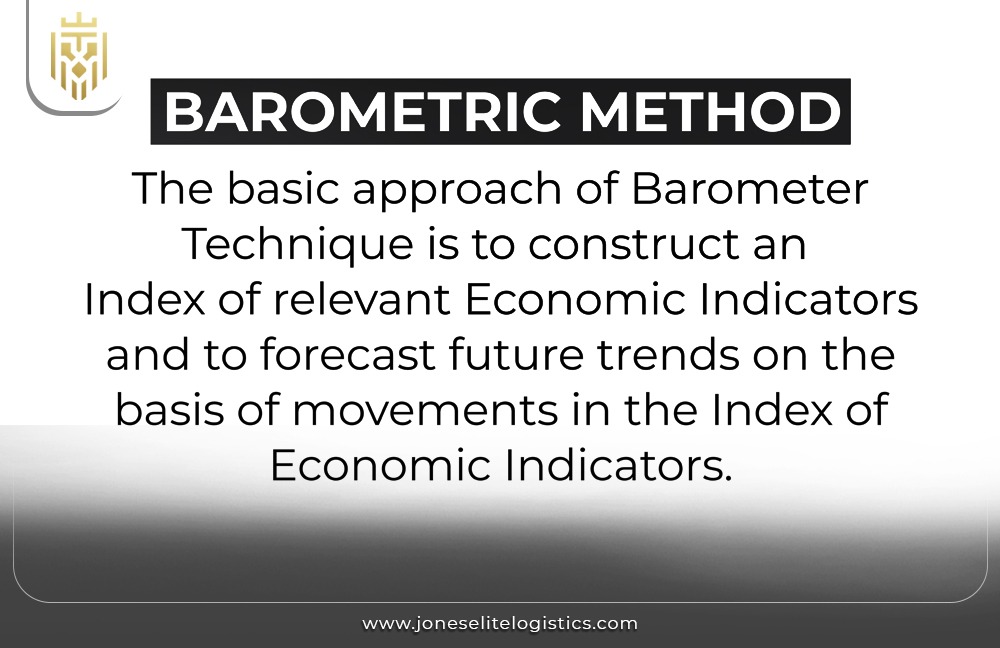
Collective Opinion Method:
The collective opinion method commonly referred to as the sales force composite method entails compiling the salespeople’s forecasts. It gives estimates based on the contacts with customers and the further experience of the salespeople. This technique relies on frontline observations from salespeople, which makes it good for short-term forecasting and offering working knowledge of the market situation.
Market Research and Delphi Method:
Market research is the process of collecting information from clients, consumers, and competitors using structured questionnaires, interviews, and focus group discussions. The Delphi method employs the use of expert panels to surmise the future demand, through a series of questions and feedback. Both of them offer rich qualitative information, which can be beneficial for a business when it comes to studying market trends and adjusting estimations.
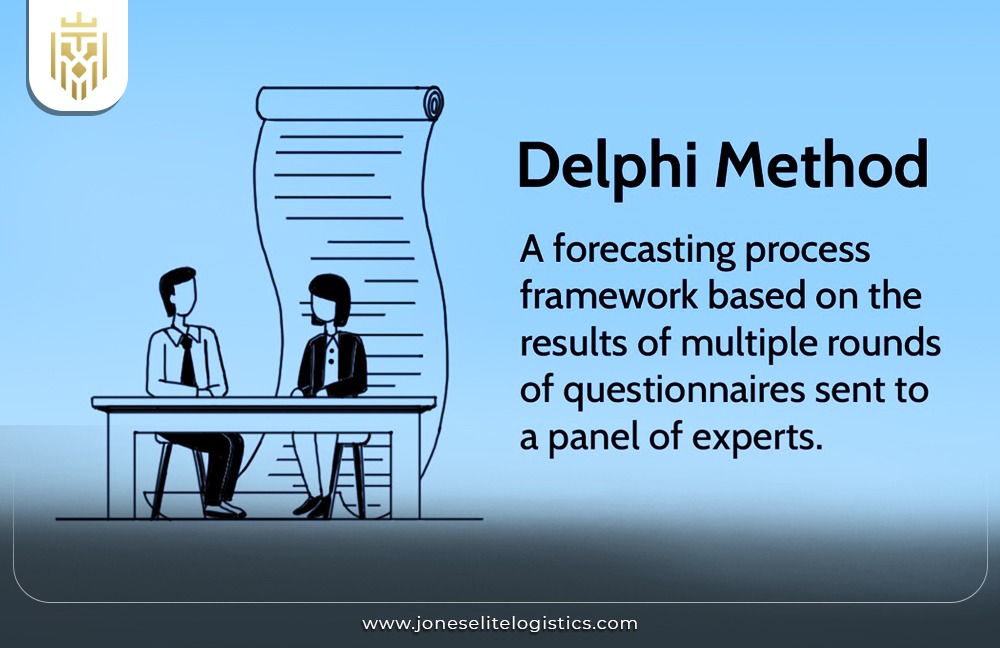
External Macro Forecasting Method:
The fourth and final external forecasting method is macro environment forecasting, where the organization makes forecasts based on external economic, political, and social systems to predict demand. This is because this approach takes into account some parameters like; regulation changes, geo-political risks, and business cycles. With an understanding of those outside factors, those risks and opportunities can be predicted, and thus the organization’s strategic plans are appropriately modified to maximize profitability and minimize the likelihood of failure.
Predictive Sales analysis method:
Business analytics is the kind of SAAS sales forecast, that also employs statistical algorithms and learning to analyze future sales based on history and tendencies. The approach can sort data and then establish relationships between the analyzed data sets and offer reliable exact and practical projections. This makes it easier to order stocks, how to manage the supply chain, and even determine the most appropriate marketing strategies.
Importance of Demand Forecasting:
Business demand forecasting plays a significant role in meeting its objectives, containing business plans, as well as customers. It assists companies in matching their capacity with that of the market, lowers expenses, decreases losses or threats, and generally boosts profitability. An ability to forecast the future means consumers can know or even control when their supplies will arrive, thus, improving their service delivery and, in the process, record high sales and growth.
Increased Efficiency:
Demand forecasting assists in reducing the waste of time and money by relating the pattern of operations such as production, inventory, and staff management to the expected demand pattern. This helps in avoiding overstocking, minimizes holding costs, and manages resources and quantities effectively. Efficient or effective management in cost allows for better resource utilization such as time and money, leading to better business performance.
Customer Satisfaction:
Demand forecasting is beneficial to organizations sometimes referred to as need fulfillment in that it assists organizations to ensure they have readily available products at the right time in the right location. By consistently avoiding stock-out and overstock conditions, companies can thus offer better solutions to their customers, improve customer confidence, and potentially gain more loyal customers. The loyal customers are the ones who are always willing to buy products again and share the information about the business.

Risk Management:
Demand forecasting enables one to analyze threats to his/her business and thus be prepared to handle issues that may develop in the future. In this aspect, firms may manage to avoid certain adverse events by seeing them in advance and, therefore, planning for them. Risk management also enhances the stability and continuation of the business organization’s processes and functions.
Improve Financial Planning:
Sales forecasting is vital in various organizational planning and decision-making processes such as strategic planning, budgeting, revenue estimation, and capital expenditure. Forecasts help businesses adjust their resource usage, plan for the future, and contribute to a business becoming financially secure. Budgeting enhances effective decision-making and overall corporate strategies as well as objectives.
Reduce Stock-Outs:
On the same note, demand forecasting will assist in avoiding stock-outs by providing accurate future expectations of the products. This helps in making sure that the inventories of the various products in the wholesale business are well replenished to meet the needs of the customers while at the same time avoiding overstocking. Minimizing stock-outs enhances the satisfaction level of the consumers, and sales continuity, and increases the potential of revenue generation due to the absence of stock-outs.
FAQs
1) What is Demand Forecasting?
Demand forecasting is a step in a retail planning process where the future quantity of customer demand for a given product or service is anticipated on the basis of its past demands, competitive analysis, and other quantitative techniques. They are used to schedule stocks, supply chains, and timely acquisition of needed merchandise within business organizations.
2) What are the types of Demand Forecasting?
Based on its nature, types of demand forecasting include passive demand forecasting and active demand forecasting, short-term demand forecasting, and long-term demand forecasting. These two types can be utilized for different business requirements and each produces different forecasts of demand.
3) What are the Demand Forecasting Techniques?
Some examples of demand forecasting techniques include moving averages, weighted moving averages, exponential smoothing techniques, regression analysis techniques, barometric methods, judgments made by groups of people, market research techniques, Delphi techniques, external macro techniques of forecasting, and predictive sales techniques.
4) What is the importance of Demand Forecasting?
Inventory forecasting is essential for improving productivity, increasing customer satisfaction, preserving risks, and achieving better financial planning, and minimizing stock-out costs. When it comes to the materialization of value, the forecast provides a foundation for the appropriate allocation of resources to match the market needs and make proper managerial decisions.







